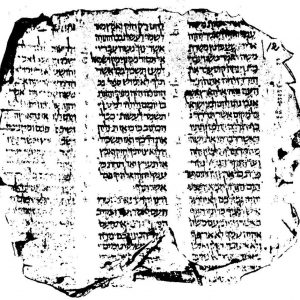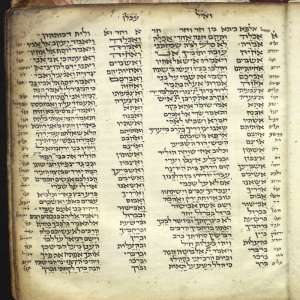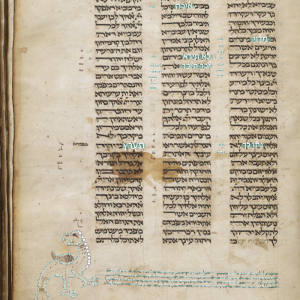About the Project
Masorah

The term “Masorah,” as it is used in modern-day scientific research, refers to any kind of metatextual element next to the consonantal text of the Hebrew Bible. It first appeared in comprehensive form in the great oriental Bible codices, like the Codex Cairensis, 895 CE; Codex Babylonicus Petropolitanus (St. Petersburg, Russian National Library, Evr. I. B 3); the Aleppo Codex; and the Codex Leningradensis (St. Petersburg, Russian National Library, Evr. I. B 19a). The Masorah comprises mise-en-page and mise-en-texte, graphemes, grammatical, syntactic, and statistical notes, as well as references and links, all of which are characteristic of not just Bible codices but also the Torah scrolls (sefer torah) used up to the present day for the liturgical service at synagogue. We distinguish between perpendicular Masorah on the side margins (the so-called masora parva) and horizontal Masorah on the lower and upper margins (masora magna) or at the very end of a book (masora finalis).
.

The Masorah has come down to us via various artifacts and in different recensions. Complete Masoretic Bibles as well as isolated Masoretic lists have been in circulation since the ninth century (e.g. Okhla we-Okhla; Sefer ha-Ḥillufim). Since the eleventh century, these were continuously taken into account in the Spanish-Provençal and the Northern French-Ashkenazi Bible commentaries, as well as in Halakhic-liturgical works and in the Hebrew-French glossaries. During this time, and under thus far historically undetermined circumstances, there emerged in medieval Ashkenaz (roughly, Germany and Northern France) a distinct Masoretic subversion of the Tiberian Masorah which deserves to be recognized as an independent textual type of Masorah due to its variant readings, its Masoretic idiosyncrasies, and especially its reception history. The Masoretic notations differ from the oriental Masorah not only with respect to the philological content, but also in its layout and mise-en-texte as masora figurata.
Masora magna, parva, and figurata

Starting in the thirteenth century, complete and partial Bibles appear in France and Germany in which the Masoretic list material, masora magna, and other list material are not only organized as linear masora magna or masora finalis, but appear in the form of decorative ornaments. In these cases, the Masorah is presented in micrographic writing that has been given pictorial form, in keeping with the standard repertoire of Romanesque Bible illuminations. It appears as legendary creatures, chimeras, dragons or drolleries, but also and especially as zoomorphic figures (dogs, horses, rabbits, gazelles, birds) and even as anthropomorphic beings, similar to façade decorations or frescoes on and in church buildings. In some instances, the Masorah was designed as diagrammatic representations, rendering scriptural constructs in geometric form (texts with a special visual structure). Manuscripts from the time leading up to the late thirteenth century demonstrate that this figurative Masorah (masora figurata), contrary to previous claims, did not necessarily lose any of its philological qualities by being presented in this form. Quite the opposite: Many lists that were relegated to the last pages in oriental codices, often making them illegible and/or untraceable, are presented in toto on the folio pages of these works and are therefore easily accessible. Masora figurata also occasionally contains additional quotations from commentary literature and Midrashim that go far beyond the usual commentaries on the biblical text, or even refer to different Bible commentaries, e.g. in MS Vat. ebr. 14.
The Aims of the Project "Corpus Masoreticum"
Reconstruction of the integration of oriental knowledge traditions into the Ashkenazi rabbinic scholarly culture: Linguistics, grammar, Masorah, exegesis
Reappraisal of the Western European Masoretic traditions between the 12th and 14th centuries: Philology and visual appearance (masora figurata)
Documentation of extant textual witnesses of the Western European Masoretic traditions: Digital edition of the Masorah
Method and Strategy: Philology and Digital Humanities
Editing Masorah of more than 15 Ashkenazi manuscripts
Edition and commentary in a digital workspace (BIMA)
Developing a user-friendly digital edition of the Masorah
Manuscript repository via IIIF (in collaboration with Heidelberg University Libary)
Graphic tools of transcribing and annotating
Encoding figurative Masorah in SVG/XML
Graph database (Neo4J) as back end and analytical tool
Export of the edition’s raw data as TEI-XML
Export of annotated digitized manuscripts as IIIF-manifests
Exploratory data analysis through text mining (Rapidminer/R)
Project Sections
A
Edition, Translation, and Contextualisation of the Masorah in Ashkenazi Biblical Manuscripts
Benjamin Blum, Dipl.-Theol.
Sebastian Seemann, M.A.
Dr. Ilona Steimann
B
Research on
Masorah outside
Biblical Manuscripts
Melissa Anwar Uthman, M.A.
C
IT Infrastructure /
DH
Development
Clemens Liedtke, M.A.